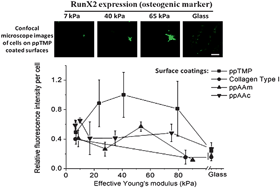Substrate induced differentiation of human mesenchymal stem cells on hydrogels with modified surface chemistry and controlled modulus†
Abstract

* Corresponding authors
a
Laboratory of Biophysics and Surface Analysis, School of Pharmacy, University of Nottingham, University Park, Nottingham, UK
E-mail:
morgan.alexander@nottingham.ac.uk
Fax: +44 (0)115 951 5102
Tel: +44 (0)115 951 5119
b Rutherford Appleton Laboratory, Harwell Science and Innovation Campus, Didcot, UK
c Centre for Biomolecular Sciences, School of Pharmacy, University of Nottingham, University Park, Nottingham, UK

 Please wait while we load your content...
Something went wrong. Try again?
Please wait while we load your content...
Something went wrong. Try again?
M. Lanniel, E. Huq, S. Allen, L. Buttery, P. M. Williams and M. R. Alexander, Soft Matter, 2011, 7, 6501 DOI: 10.1039/C1SM05167A
To request permission to reproduce material from this article, please go to the Copyright Clearance Center request page.
If you are an author contributing to an RSC publication, you do not need to request permission provided correct acknowledgement is given.
If you are the author of this article, you do not need to request permission to reproduce figures and diagrams provided correct acknowledgement is given. If you want to reproduce the whole article in a third-party publication (excluding your thesis/dissertation for which permission is not required) please go to the Copyright Clearance Center request page.
Read more about how to correctly acknowledge RSC content.
 Fetching data from CrossRef.
Fetching data from CrossRef.
This may take some time to load.
Loading related content
